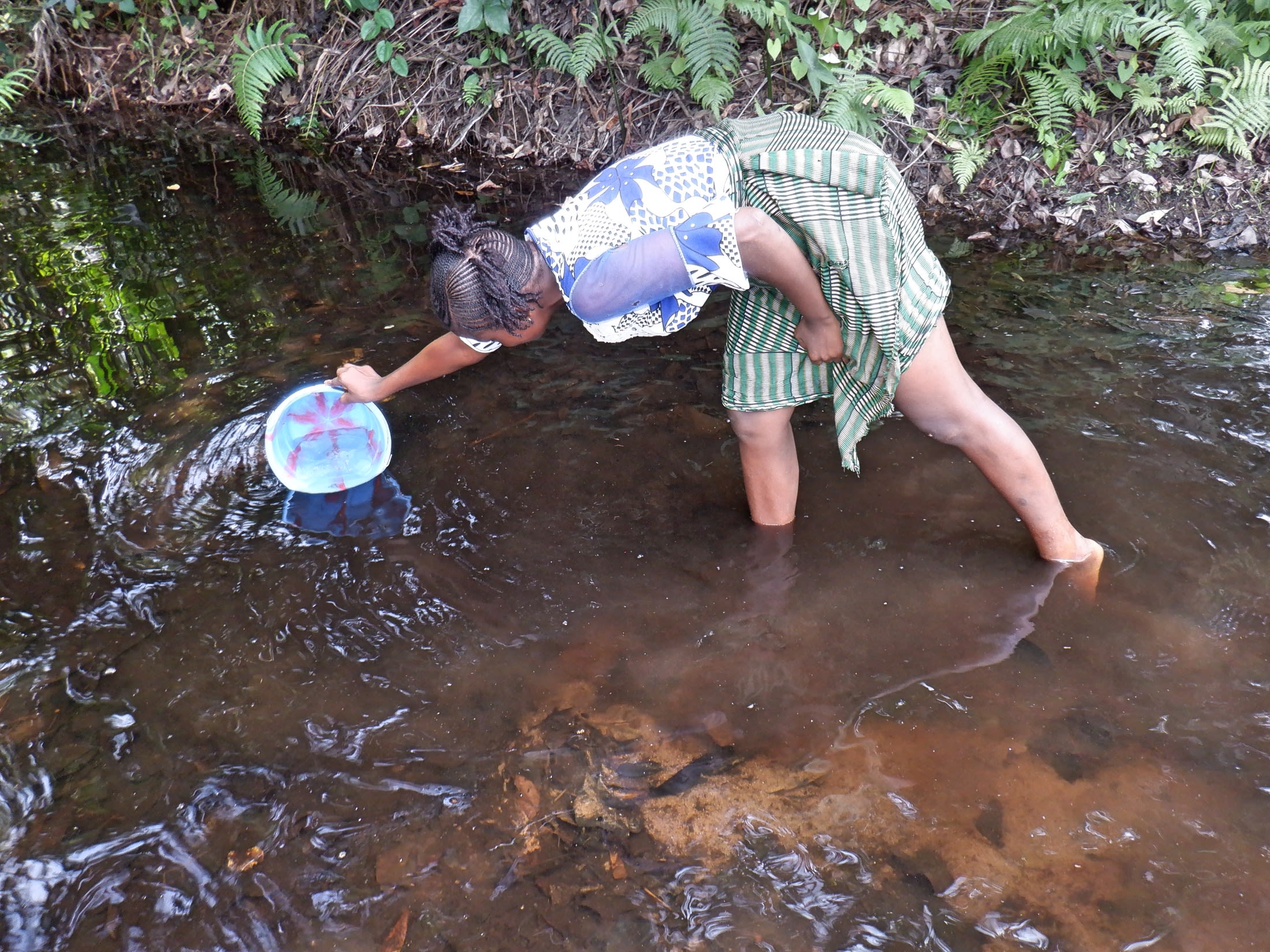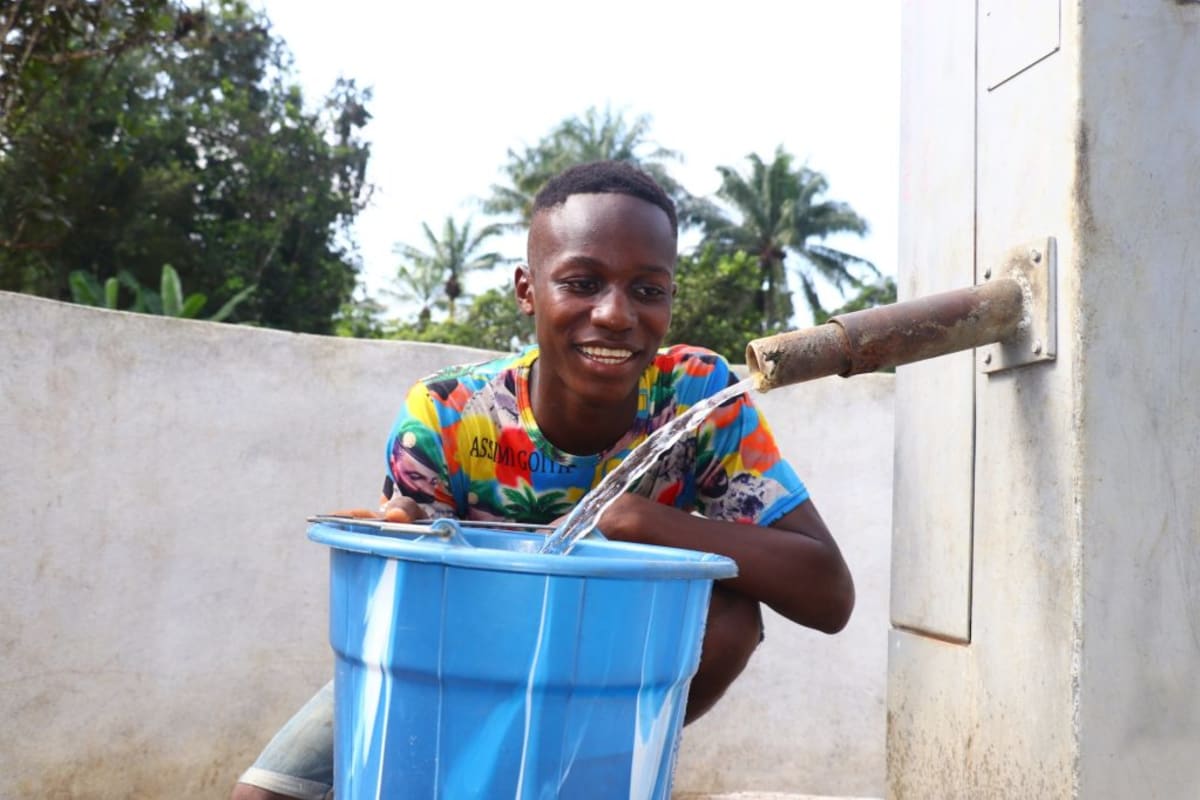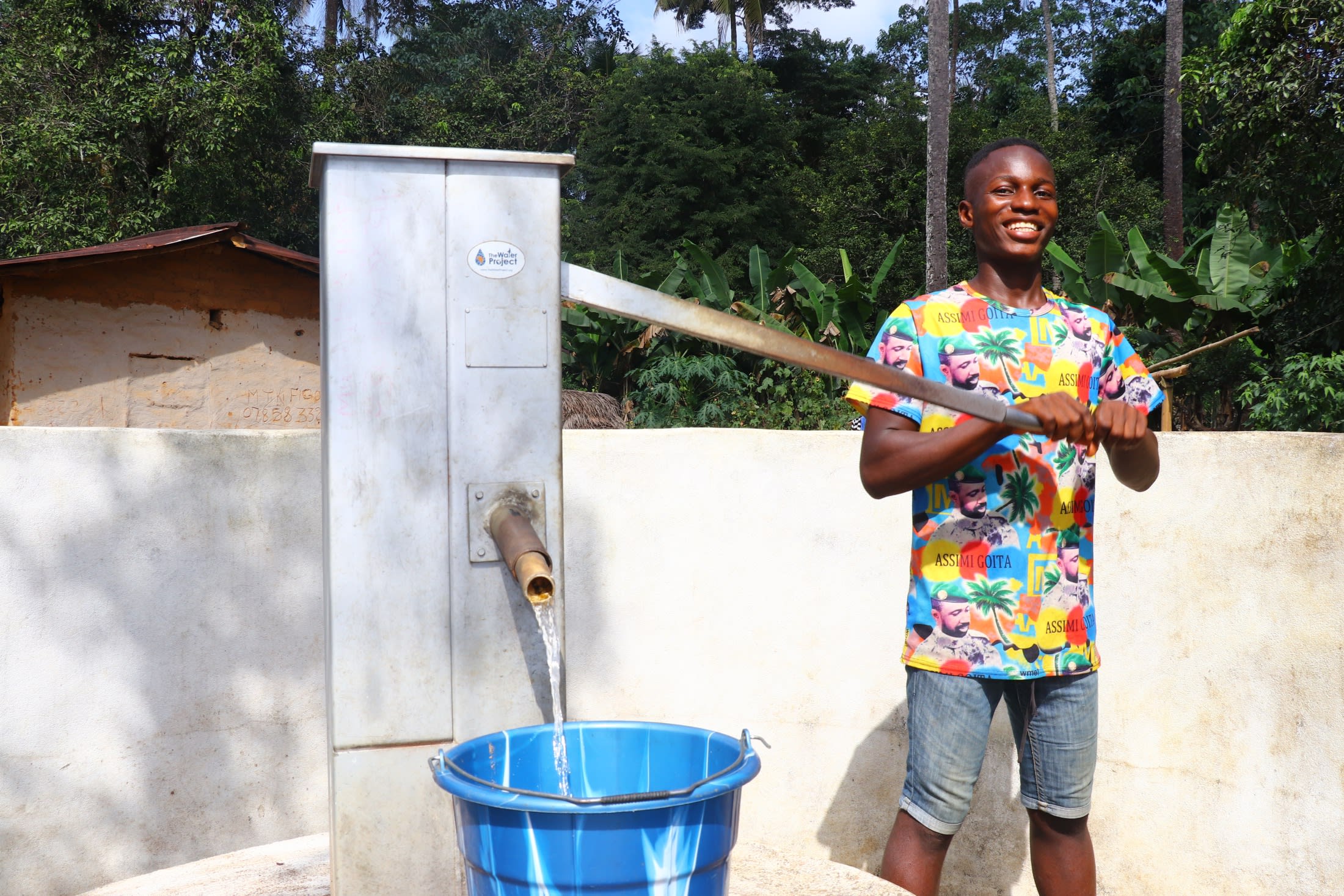February, 2023: Santiguiya Neneh Community Well Rehabilitation Complete!
We are excited to share that a safe, reliable water point at Santiguiya Neneh Community in Sierra Leone is now providing clean water to community members! We also conducted hygiene and sanitation training, which focused on healthy practices such as handwashing and using latrines.
"Today is a momentous day to me because I now have easy access to safe drinking water," said 51-year-old farmer Ya N'Mah Bangura. "I am grateful today because of the rehabilitation of this water well. It is now providing enough water for everyone in this village. I [won't] worry about fetching water from the stream, even during the dry season, because there is enough water coming out from this pump."

N'mah cups her hands beneath the well's spout.
N'mah explained what made accessing water so difficult before. "The stream water is not safe because there is no way that we can cover it from the reach of animals. Sometimes the stream gets filthy, but I had no other means of getting drinking water. So, I had to drink from the stream. I hardly [fetched] enough water from the stream during that time because of the long distance and the low flow of water. This affected my commitment to farming activities and the completion of my domestic duties. When there was no one to help me, I struggled to fetch water for my family."
14-year-old Ibrahim K. experienced similar struggles getting water for his household.
"I fetched water from the stream in the morning when the well [was] not providing water," he explained.

Ibrahim collects water from the new well.
"I needed to fetch water from the stream before late in the evening because I could not go there alone. The stream area is not safe for me due to the presence of snakes and other harmful animals. I hardly could be able to do my schoolwork at home because of fatigue after fetching water from the stream. I can now fetch enough water from the water well because it is next to my house. I will no longer walk far to the stream for water. I now have more time in the morning to do domestic duties and fetch water to bathe before going to school without getting late."

We held a dedication ceremony to officially hand over the well to the community members. Several local dignitaries attended the ceremony, including representatives from the Port Loko District Council and the Ministry of Water Resources. Each official gave a short speech thanking everyone who contributed to the rehabilitation of the water project and reminding everyone to take good care of it. Then, N'mah and Ibrahim made statements on their community's behalf. The ceremony concluded with celebration, singing, and dancing.
Clean Water Restored
The drill team arrived the day before beginning work. They set up camp and unpacked all their tools and supplies to prepare for drilling the next day. The community provided space for the team to store their belongings and meals for the duration of their stay. The following day, the work began.
First, we raised the tripod, the structure we use to hold and maneuver each drilling tool. Next, we measured the well's original depth. We then socketed the pipes and installed a casing.

Setting up the drill rig.
Finally, we lined up the drill rods and started to drill! We reached a final depth of 21 meters with water at ten meters. The hand-drill method allowed the team to install the cylinder far below the aquifer so that the community has excellent water access throughout the year.
With drilling complete, we installed screening and a filter pack to keep out debris when the water is pumped. We then cemented an iron rod to the well lining and fixed it with an iron collar at the top.

Bailing.
Next, we bailed the well by hand for three days and flushed it, clearing any debris generated by the drilling process. Finally, we tested the yield to ensure the well would provide clean water with minimal effort at the pump.

Building the well platform.
As the project neared completion, we built a new cement platform, walls, and drainage system around the well to seal it off from surface-level contaminants. The drainage system helps to redirect runoff and spilled water to help avoid standing water at the well, which can be uncomfortable and unhygienic and a breeding ground for disease-carrying mosquitoes.
At last, we installed the pump and conducted a water quality test. The test results showed that this was clean water fit for drinking!

Finished well.
New Knowledge
Before conducting any hygiene training, we called and visited the local water user committee to understand the community’s challenges and lack of sanitation facilities. We shared the findings from our discussions with the committee members to help them make the necessary adjustments before the training began. For example, we identified households without handwashing stations or ones that may need to repair their latrines. With this information, community members worked together to improve hygiene and sanitation at home.
We also invited a nurse from the local clinic to help explain some topics and spread awareness about Sierra Leone's free vaccinations for children under five. Nurse Fatmata was instrumental in reinforcing each lesson.

Nurse Fatmata demonstrates storing a toothbrush.
After this preparatory period, we scheduled a time when members from each household using the water point could attend a three-day hygiene and sanitation training. We then dispatched our teams to the agreed-upon location to hold the meeting.
Training topics covered included handwashing and tippy taps, good and bad hygiene habits, disease transmission and prevention, COVID-19, worms and parasites, dental hygiene, proper care of the well's pump, keeping the water clean, the cost recovery system, dish racks and clotheslines, the importance of toilets, keeping latrines clean, balanced diets, the diarrhea doll, and HIV and AIDS.

Community members hold up posters showing disease transmission.
The topic that prompted the most discussion for participants was nutrition. Some of our recommendations went against people's traditional beliefs, such as not allowing children to eat certain foods like eggs, plantains, or ripe bananas. Similarly, pregnant or lactating mothers in Santiguiya Neneh weren't eating leftover rice or oranges for fear of passing undesired consequences to their babies.

We demonstrate nutrition using a three-legged stool, with each leg representing an important food group.
"All their doubts, concerns, and questions were answered with clarity without making them feel inferior," said our field officer, Phillip. "The nurse highlighted the importance and nutritious value of these foodstuffs and their functions in the body during pregnancy and childhood. Therefore, they were encouraged to be allowing everyone, particularly children, to eat all categories of foods, provided they are not allergic to them. Because their [bodies] need [food] for growth, repair of worn-out tissues, strengthening their immune system, and providing energy for their bodies. They were all amazed at this new knowledge and promised to do as they had learned."
Another enlightening topic was malaria, the origins of which had been misconstrued by community members.
"To them, malaria was caused by the common cold, bedbugs, oranges, mangoes, and dirty foods," field officer Philip said. "It was surprising for them to know that the only cause of malaria is a mosquito bite."
"At first, we were all blind by our traditional beliefs about various foods, especially when it comes to feeding children, suckling mothers, and pregnant women," said 41-year-old farmer Alusine Conteh.

Alusine on the day of the training.
"But all thanks to our facilitators and able nurses, who have [opened] our eyes by telling us about the importance of food to our bodies. Again, this community used to embark on lots of traditional treatments than going to the hospital. But thank God we all are now aware that home treatment, mostly herbs, can be dangerous to our health because these native medicines have no dosage. I have learned that one must know the disease you are suffering from first before taking medication, because blind treatment is not good. Therefore, I am encouraging all to not just learn these things, but we should try our best to practice them correctly."
Conclusion
This project required a substantial collaboration between our staff, our in-country teams, and the community members themselves. When an issue arises concerning the well, community members are equipped with the necessary skills to rectify the problem and ensure the water point works appropriately. However, if the issue is beyond their capabilities, they can contact their local field officers to assist them.
Also, we will continue to offer them unmatchable support as a part of our monitoring and maintenance program. We walk with each community, problem-solving together when they face challenges with functionality, seasonality, or water quality. Together, all these components help us strive for enduring access to reliable, clean, and safe water for this community.
With your contribution, one more piece has been added to a large puzzle of water projects. In our target areas, we’re working toward complete coverage of reliable, maintained water sources within a 30-minute round trip for each community, household, school, and health center. With this in mind, search through our upcoming projects to see which community you can help next!
Thank you for making all of this possible!




 Borehole Well and Hand Pump
Borehole Well and Hand Pump































